高校教师工作量管理系统的设计与实现英文文献翻译教学文稿
- 格式:docx
- 大小:22.82 KB
- 文档页数:7
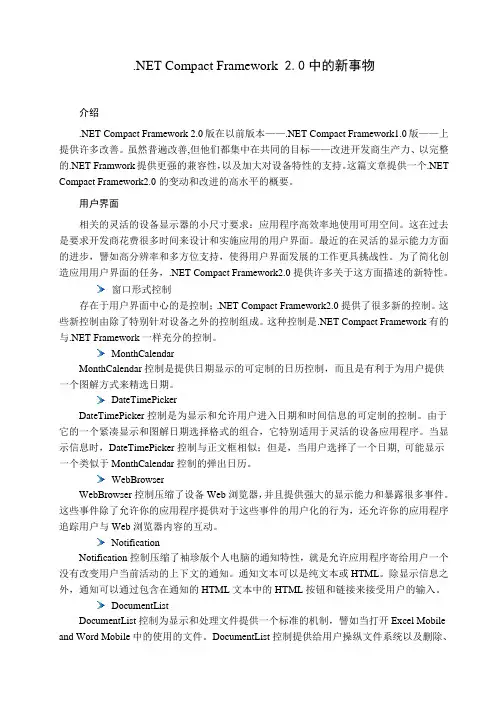
.NET Compact Framework 2.0中的新事物介绍.NET Compact Framework 2.0版在以前版本——.NET Compact Framework1.0版——上提供许多改善。
虽然普遍改善,但他们都集中在共同的目标——改进开发商生产力、以完整的.NET Framwork提供更强的兼容性,以及加大对设备特性的支持。
这篇文章提供一个.NET Compact Framework2.0的变动和改进的高水平的概要。
用户界面相关的灵活的设备显示器的小尺寸要求:应用程序高效率地使用可用空间。
这在过去是要求开发商花费很多时间来设计和实施应用的用户界面。
最近的在灵活的显示能力方面的进步,譬如高分辨率和多方位支持,使得用户界面发展的工作更具挑战性。
为了简化创造应用用户界面的任务,.NET Compact Framework2.0提供许多关于这方面描述的新特性。
窗口形式控制存在于用户界面中心的是控制;.NET Compact Framework2.0提供了很多新的控制。
这些新控制由除了特别针对设备之外的控制组成。
这种控制是.NET Compact Framework有的与.NET Framework一样充分的控制。
MonthCalendarMonthCalendar控制是提供日期显示的可定制的日历控制,而且是有利于为用户提供一个图解方式来精选日期。
DateTimePickerDateTimePicker控制是为显示和允许用户进入日期和时间信息的可定制的控制。
由于它的一个紧凑显示和图解日期选择格式的组合,它特别适用于灵活的设备应用程序。
当显示信息时,DateTimePicker控制与正文框相似;但是,当用户选择了一个日期, 可能显示一个类似于MonthCalendar控制的弹出日历。
WebBrowserWebBrowser控制压缩了设备Web浏览器,并且提供强大的显示能力和暴露很多事件。
这些事件除了允许你的应用程序提供对于这些事件的用户化的行为,还允许你的应用程序追踪用户与Web浏览器内容的互动。
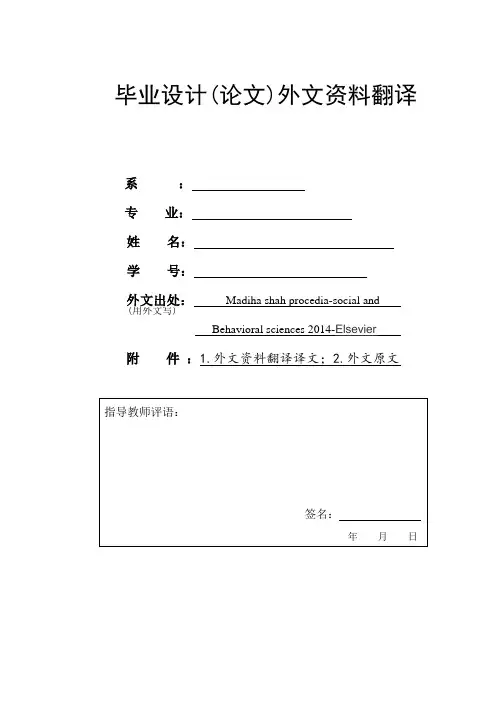
毕业设计(论文)外文资料翻译系 :专 业:姓 名:学 号:外文出处: Madiha shah procedia-social and附 件 :1.外文资料翻译译文;2.外文原文(用外文写)附件1:外文资料翻译译文管理信息系统(MIS)对学校的影响-----文献报告Madiha Shah Malaysia. Malaya大学马来西亚摘要鉴于其快捷和有效性,教育管理信息技术的使用已迅速增加。
在其发展的初始阶段,管理信息系统(MIS)的主要目的和使用是改善学校办公室活动的效率。
它是用于存储的学生和全体职工的数据。
最重要的的是重要数据录入和整理,而不是在数据传输或分析。
管理信息的价值当时被人们公认。
在集成阶段,全盘回顾文献,其强调积极影响学校管理和管理信息系统管理,包括更好的可访问性信息,更有效的管理,学校资源更高的利用率同时也减少了工作量,更好的时间管理,提高报告的质量。
对于信息管理系统,大量的抑制剂的使用在文献中很明显,其中最重要的是缺乏时间,缺乏信心或能力,缺乏培训,缺乏高层管理人员的支持,缺乏技术支持等。
管理信息系统可以提供所需的信息通知计划、决策和评估方面相关的管理员和教师。
管理信息系统改变了学校管理领域的领导、决策、工作负载、人力资源管理、沟通、责任,规划等方方面面。
这些系统可以帮助学校管理者在决定学校的目标,制定战略计划,分配资源,评估员工的绩效以及组织时更加顺利。
关键词: 管理信息系统、MIS 、学校管理、学校管理。
1、介绍电脑被视为有潜力在教学、学习和学校的管理方面做出重大的贡献。
信息和介绍通信技术(ICT)进入到学校包括硬件、软件、网络和员工发展的广泛的投资被认为是值得的前提。
如果有证据表明,它使在学校的表现和产生相应的影响有效性(Condie et al .,2007)真实存在。
利用信息技术在教育管理就会由于其效率和迅速增加有效性。
学校管理人员花大量的时间用于解决复杂的分配问题(如人员分配、资源分配、时间安排)和监控学校的操作已经有了更好的选择旨运用发展该技术。

教学工作量管理系统的设计与实现【摘要】本文旨在设计和实现一套教学工作量管理系统,以提高教师教学工作的效率和管理水平。
在首先介绍了研究背景,指出当前教学工作管理存在的问题和挑战。
其次阐述了研究意义,说明通过建立和完善教学工作量管理系统可以提升教学质量和效率。
最后明确了研究目的,即为了解决教师教学工作中的管理问题,提高教学质量。
在首先进行了教学工作量管理系统的设计,包括需求分析、系统架构设计等内容。
然后详细讨论了系统的实现和测试过程,确保系统的稳定性和可靠性。
最后在对教学工作量管理系统的设计与实现效果进行评价,总结系统的优势和不足,并展望未来的发展方向。
通过本文的研究,可以为教师教学工作提供更加便捷和有效的管理工具,从而提升整体教学质量和效率。
【关键词】教学工作量管理系统,设计与实现,需求分析,系统架构设计,系统测试,效果评价,优势,不足,展望未来1. 引言1.1 研究背景教学工作量管理系统是为了解决教师工作量管理中存在的问题而开发的一种信息化工具。
随着教育信息化的发展,教师的工作量管理变得越来越复杂,传统的手工方式已经无法满足现代教育管理的需求。
现有的教学工作量管理系统多为单一功能,缺乏整体性和综合性,不能有效地支持教师的工作。
设计一种更加完善和智能化的教学工作量管理系统变得尤为重要。
通过采用现代信息技术,将教学工作量管理系统整合到教育信息化系统中,可以提高教师工作效率,减轻其工作负担,提升教学质量。
通过数据分析和优化,还可以为学校领导提供决策支持,帮助学校更好地管理教学资源,实现教育资源的合理配置和利用。
针对当前教师工作量管理中存在的问题和挑战,本研究旨在设计和实现一种智能化的教学工作量管理系统,为教师和学校提供更加科学、便捷和高效的工作量管理工具。
通过深入研究现有的教学工作量管理系统,分析其存在的问题和不足,完善系统设计,提高系统的功能性和实用性,以满足教育管理的需求。
1.2 研究意义教学工作量管理系统是当前教育管理领域中一个非常重要的系统,在教育教学工作中扮演着至关重要的角色。
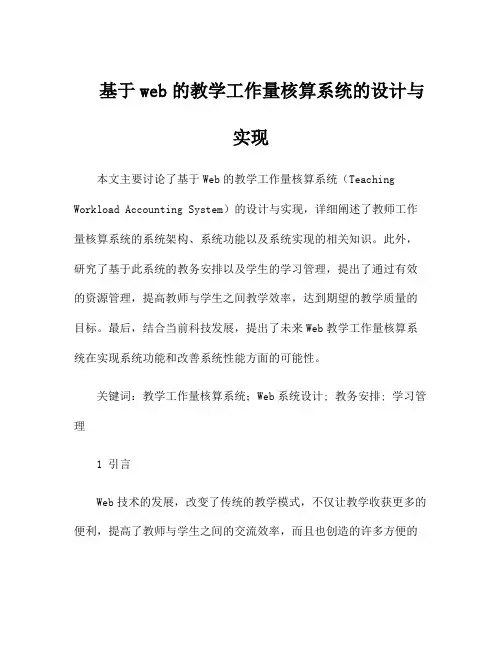
基于web的教学工作量核算系统的设计与实现本文主要讨论了基于Web的教学工作量核算系统(Teaching Workload Accounting System)的设计与实现,详细阐述了教师工作量核算系统的系统架构、系统功能以及系统实现的相关知识。
此外,研究了基于此系统的教务安排以及学生的学习管理,提出了通过有效的资源管理,提高教师与学生之间教学效率,达到期望的教学质量的目标。
最后,结合当前科技发展,提出了未来Web教学工作量核算系统在实现系统功能和改善系统性能方面的可能性。
关键词:教学工作量核算系统;Web系统设计; 教务安排; 学习管理1 引言Web技术的发展,改变了传统的教学模式,不仅让教学收获更多的便利,提高了教师与学生之间的交流效率,而且也创造的许多方便的高效的教学工具。
在此基础上,一个基于Web的教学工作量核算系统(Teaching Workload Accounting System)应运而生。
2 系统功能基于Web的教学工作量核算系统主要由课程管理、教师管理、学生管理以及统计报表等几部分组成。
(1)课程管理:课程管理系统主要负责教师的教学课程的管理。
教师可以创建、编辑和管理教学内容,安排教学安排,上传教学资源以及提交教学报告等。
(2)教师管理:教师管理系统主要为管理员在管理和安排教师教学活动提供全面的帮助。
管理员可以查看教师的教学进度,调整教师的教学安排,监控教师的教学效果,以及查看教师的评价和总结等。
(3)学生管理:学生管理系统主要为学生提供学习管理的功能,实现学生的及时学习跟踪,帮助学生提高学习效率,并形成学习管理数据报表,供管理员进行查看和评估。
(4)统计报表:教师工作量核算系统还具有统计功能,可以根据教师和学生的学习记录,分析教师和学生的学习进展情况,从而为管理部门制定出有效的学习管理模式,实现学校期望的教学质量要求。
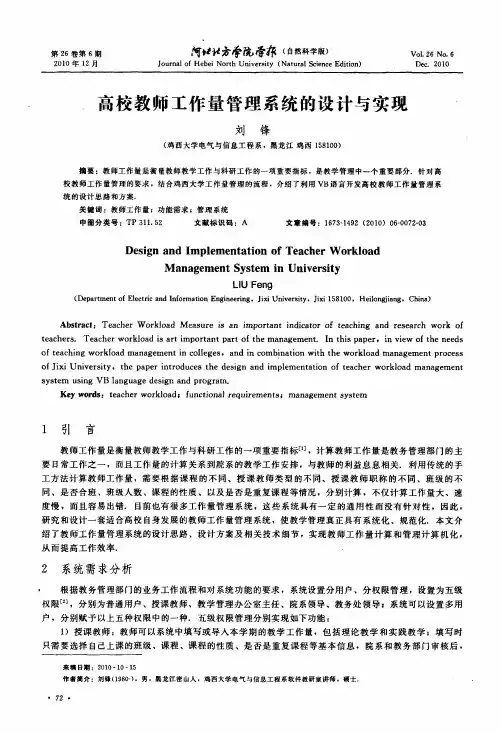
第26卷第6期2010年12月阿"弘方学院学存(自然科学版)Jour na l of H e b e i N or t h U n i ver s i t y(N a t ur al Sci ence E di t i o n)V oI.26N O.6D ec.2010高校教师工作量管理系统的设计与实现刘锋(鸡西大学电气与信息工程系,黑龙江鸡西158100)摘要:教师工作量是衡量教师教学工作与科研工作的一项重要指标,是教学管理中一个重要部分.针对高校教师工作量管理的要求,结合鸡西大学工作量管理的流程,介绍了利用V B语言开发高校教师工作量管理系统的设计思路和方案.关键词:教师工作量;功能需求;管理系统中图分类号:T P31I.52文献标识码:A文章编号:1673—1492(2010)06—0072—03D e s i gn and I m pl em ent at i on of Tea cher W or kl oadM a nage m ent Sys t em i n U ni ver si t yL I U Feng(D epart m en t of E l ect r i c and Inform at i on E ngi nee r i ng。
J i xi U ni ver si t y,Ji xi158100,H ei l ongj i a ng,C hi na)A bs t r ac t:Teach er W or kl oad M ea s ur e is an i m p or t a nt i ndi ca t or of t eachi ng and r es ear ch w o r k of t ea cher s.Teach er w or kl oa d i s ar t i m p or t a nt pa rt of t he m ana ge m ent.I n t h i s paper,i n vi ew of t he needs of t eachi ng w or kl oa d m anagem ent i n col l ege s,and i n c om b.i na t i on w i t h t he w or kl oad m a n a ge m ent pr oce s s of Ji xi U ni v er s i t y,t he pape r i nt r o duces t he des i gn and i m p l em e nt at i on of t eacher w or kl oa d m a n a ge m ent sys t em us i ng VB l angu age des i gn and pr o gr am.K ey w or d s:t eac her w or k l oad;f unct i o nal r e qui r e m ent s;m ana gem e nt syst e m1引言教师工作量是衡量教师教学工作与科研工作的一项重要指标[1],计算教师工作量是教务管理部门的主要日常工作之一,而且工作量的计算关系到院系的教学工作安排,与教师的利益息息相关.利用传统的手工方法计算教师工作量,需要根据课程的不同、授课教师类型的不同、授课教师职称的不同、班级的不同、是否合班、班级人数、课程的性质、以及是否是重复课程等情况,分别计算,不仅计算工作量大、速度慢,而且容易出错.目前也有很多工作量管理系统,这些系统具有一定的通用性而没有针对性,因此,研究和设计一套适合高校自身发展的教师工作量管理系统,使教学管理真正具有系统化、规范化。
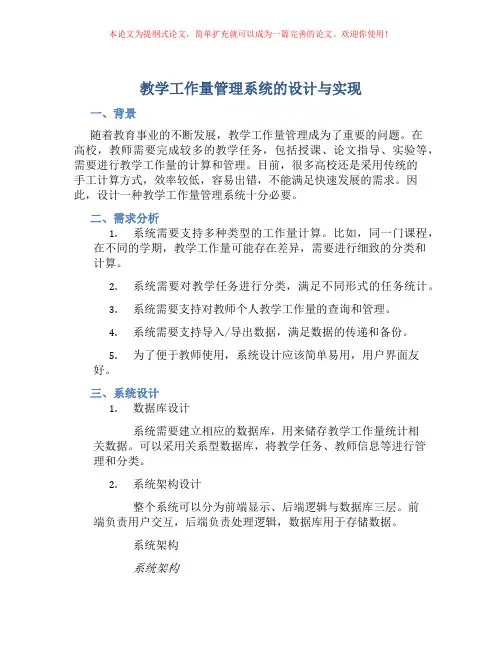
教学工作量管理系统的设计与实现一、背景随着教育事业的不断发展,教学工作量管理成为了重要的问题。
在高校,教师需要完成较多的教学任务,包括授课、论文指导、实验等,需要进行教学工作量的计算和管理。
目前,很多高校还是采用传统的手工计算方式,效率较低,容易出错,不能满足快速发展的需求。
因此,设计一种教学工作量管理系统十分必要。
二、需求分析1.系统需要支持多种类型的工作量计算。
比如,同一门课程,在不同的学期,教学工作量可能存在差异,需要进行细致的分类和计算。
2.系统需要对教学任务进行分类,满足不同形式的任务统计。
3.系统需要支持对教师个人教学工作量的查询和管理。
4.系统需要支持导入/导出数据,满足数据的传递和备份。
5.为了便于教师使用,系统设计应该简单易用,用户界面友好。
三、系统设计1.数据库设计系统需要建立相应的数据库,用来储存教学工作量统计相关数据。
可以采用关系型数据库,将教学任务、教师信息等进行管理和分类。
2.系统架构设计整个系统可以分为前端显示、后端逻辑与数据库三层。
前端负责用户交互,后端负责处理逻辑,数据库用于存储数据。
系统架构系统架构3.功能模块设计系统主要包含以下功能模块:–用户登录/注册:教师通过该功能进入系统,使用相应的权限进行操作。
–任务管理:管理员/教务处添加并分类不同类型的教学任务,方便统计教学工作量。
–教师信息管理:管理员/教务处添加或修改教师个人信息,包括姓名、职称、所在部门等。
–教学工作量统计:系统利用任务管理中的数据,按照分类方式计算教师的教学工作量。
–数据导入/导出:支持导入导出数据,方便数据传输和备份。
4.用户界面设计界面应该符合用户直观、易懂、简洁和美观的需求。
整体界面设计可以参考以下原则:–显示位置和同类信息放置在同一个位置。
–使用明确的视觉元素来提示用户使用目前所在界面的功能。
–将界面设计成易于客户使用的模式,而非基于系统设计者的技术。
5.后端逻辑设计后端逻辑主要负责对用户请求进行响应,并进行相应的操作。
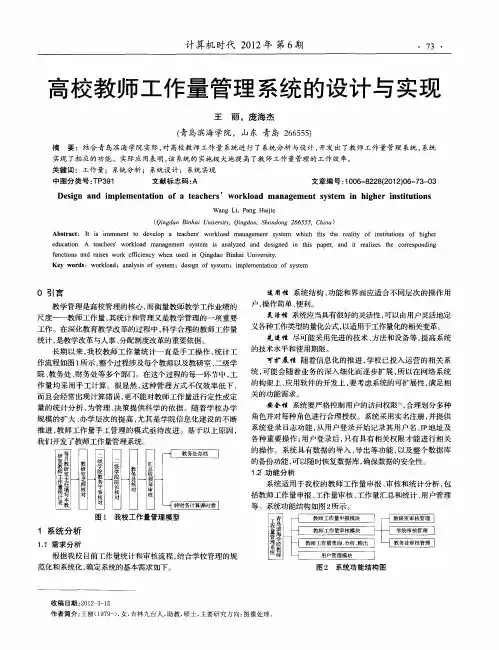

教学与管理投稿字数(中英文实用版)Title: Teaching and AdministrationSubmission Word Count: 500 wordsThe integration of teaching and management is essential in any educational institution.It is through this integration that a conducive learning environment is created, enabling students to reach their full potential.As an educator, I firmly believe that effective teaching cannot be separated from effective management.教学与管理的融合在任何教育机构中都是至关重要的。
正是通过这种融合,才创造了一个有利于学习的环境,使学生能够充分发挥潜力。
作为一名教育工作者,我坚信,有效的教学不能脱离有效的管理。
In order to create a positive learning atmosphere, it is necessary for teachers to establish clear expectations and rules for classroom behavior.By doing so, students will understand the standards that are expected of them and will be more likely to comply with them.Additionally, effective management involves consistent enforcement of these rules, ensuring that students are held accountable for their actions.为了创造一个积极的学习氛围,教师有必要为课堂行为设定明确的要求和规则。
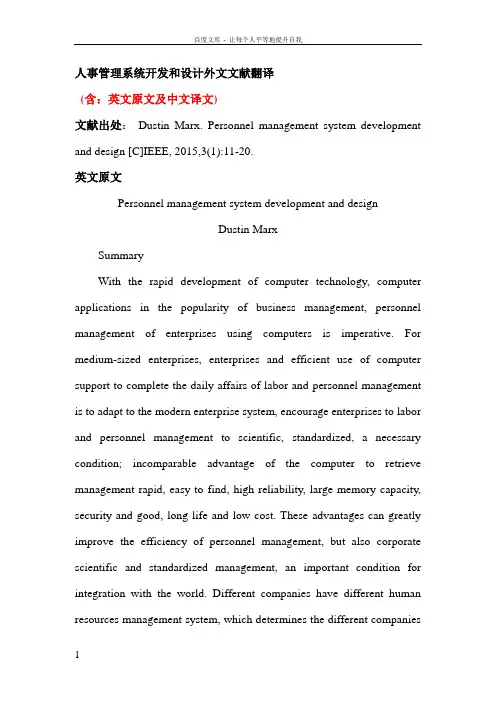
人事管理系统开发和设计外文文献翻译(含:英文原文及中文译文)文献出处:Dustin Marx. Personnel management system development and design [C]IEEE, 2015,3(1):11-20.英文原文Personnel management system development and designDustin MarxSummaryWith the rapid development of computer technology, computer applications in the popularity of business management, personnel management of enterprises using computers is imperative. For medium-sized enterprises, enterprises and efficient use of computer support to complete the daily affairs of labor and personnel management is to adapt to the modern enterprise system, encourage enterprises to labor and personnel management to scientific, standardized, a necessary condition; incomparable advantage of the computer to retrieve management rapid, easy to find, high reliability, large memory capacity, security and good, long life and low cost. These advantages can greatly improve the efficiency of personnel management, but also corporate scientific and standardized management, an important condition for integration with the world. Different companies have different human resources management system, which determines the different companiesneed different personnel management system.Choice of development toolsNow, the market can buy a lot of application development products, popular, and dozens. Currently the most popular in our market, the most used, most advanced development tools can be used as enterprise-level products:Microsoft's Visual BasicMicrosoft's Visual CBorland's DelphiJava, etc.In the current market, many application development tools for these, some stressed that the implementation of process flexibility and efficiency of language; and some emphasis on the visual application development tools to bring convenience and efficiency high, each with its own advantages and characteristics, but also to meet the needs of different users. However, the language of the flexibility and convenience tools are inextricably linked, and only a convenient tool, but did not support the language of flexibility, many specialized processing actions will need to spend several times the effort to deal with, so the efficiency of the original advertisedloss of a role in improving the advantage; the contrary, if the language only emphasizes the flexibility of process continued, but no convenient tool for co-ordination will make some verysimple interface, even if the deal moves, programmers will be a serious waste of valuable time.As the database system development, Visual Basic is an ideal choice. MIS database is an important enabling technology in the MIS development process, how to choose the database management is an important issue, at present, the database more products, each product has its own characteristics and scope, therefore, the choice of database should consider the characteristics of database applications and application, the system's database language used Visual Basic language, the development tool has many advantages:Visual Basic is a visual, object-oriented and event-driven article by the way of structured high-level programming, can be used to develop the type of Windows environment applications. It is easy to learn, efficient, and powerful, with professional development tools, Windows SDK comparable to, and application developers do not have the C / C + + Programming. In the Visual Basic environment, the use of event-driven programming mechanism, novel-to-use visual design tools, the use of Windows internal application program interface (API) functions, and dynamic-link library (DLL), Dynamic Data Exchange (DDE), Object Linking and Embedding (OLE), Open Data Access (ODBC) technology, can efficiently and quickly developed a Windows environment, powerful, rich graphical user interface application software system.In general, Visual Basic has the following characteristics:Visual Programming:Traditional programming language design program, are designed by writing code to the user interface, the interface design process do not see the actual display, run the program to be compiled can be observed. If you are not satisfied with the effect of the interface, but also return to the program changes. Sometimes, this programming - Compiler - Change the operation may be repeated several times, greatly affected the efficiency of software development. Visual Basic provides a visual design tool, the complexity of the Windows interface design "package" together, developers do not have a lot of interface design and write press the screen layout design, using system tools to draw on the screen various "parts", that is, graphical objects, and set the properties of these graphical objects. Visual Basic code automatically generated interface design, programmers need only write the part to achieve functionality of the program code, which can greatly improve the efficiency of program design.Object-oriented programmingVisual Basic support for future object-oriented programming, but it is the general object-oriented programming language (C + +) are not identical. In general object-oriented programming language, object code and data from the composition of an abstract concept; and Visual Basic isthe application of object-oriented programming methodology (OOP), the programs and data encapsulated as an object and should be given for each object the attributes of the object as something real. In the design of objects, without writing to establish and describe each object code, but with the tool to draw the interface, Visual Basic automatically generates the object code and package it. Each object is displayed graphically in the interface are visible. Structured programming languageVisual Basic is based on the BASIC language developed, high-level programming language with sentence structure, similar to the logic of natural language and human thinking. Visual Basic statements easy to understand, its editor supports color code, can automatically check for syntax errors, but also has powerful and flexible to use debugger and compiler.Visual Basic is an interpreted language, enter the code at the same time, decomposition of high-level language interpretation system will be translated into machine instructions the computer can recognize and judge each statement syntax error. Visual Basic procedures in the design process, you can always run the program, and in the whole process a good design, you can compile an executable file (. EXE), from the Visual Basic environment, directly in the Windows environments.Event-driven programming mechanismVisual Basic object through the event to perform the operation. Anobject may have multiple events, each event are available through a program to respond. For example, the command button is an object, when the user clicks the button, will generate a "click" (CLICK) event, but in the production of the event will execute a program used to implement the specified operation.In the design of large-scale applications using Visual Basic software, without creatinga clear beginning and end of the procedure, but the preparation of a number of small subroutines that process. These processes are aimed at different objects, an event triggered by the user to drive the completion of a particular function or procedure called by the generic event-driven process to perform the specified operation, so that programmers can easily and improve efficiency.Access to the databaseVisual Basic has a powerful database management features, the use of data control and database management window, you can directly create or deal with Microsoft Access database format, and provides powerful data storage and retrieval capabilities. At the same time, Visual Basic can also directly edit, and access to other external databases, such as DBASE, FoxPro, Paradox, etc. These database format can be edited and processed using Visual Basic.Visual Basic provides an open data connection, the ODBC functions,can be established through direct access or use the connection and operation of large-scale network database backend such as SQL Server, Oracle and so on. In the application, you can use structured query language SQL data standards, direct access to the server database and provides a simple object-oriented database instructions and multi-user database access locking mechanism and network programming SQL databasestechnology for stand-alone databases running on the SQL network interface to a distributed environment, fast and effective implementation of client / server (client / server) programs.Dynamic Data Exchange (DDE)Using Dynamic Data Exchange (Dynamic Data Exchange) technology, an application can dynamically link the data to another application, so that two completely different applications, establish a dynamic data link. When the original data changes, you can automatically update the linked data. Visual Basic provides the programming dynamic data exchange technology, the application program with other Windows applications to create dynamic data exchange between different applications to communicate. Object Linking and Embedding (OLE) Object Linking and Embedding (OLE) to each application as an object (object), to link different objects (link) up, and then embedded (embed) an application, which can be a sound, image, image, animation, text and other information collection style technology is Microsoft'sstrategic corporate object technology, which the multiple applications into one, as each application for an object linking and embedding, is an application integration technology. Using OLE technology, you can easily build composite documents (compound document), this document from a number of different application objects, each object in the document and linked to the original application, and perform with the original application the same operation. Dynamic link library (DLL)Visual Basic is an advanced programming language, do not have low-level language functions, the operation of the access to the machine hardware is not easy to implement. But it could be dynamic link library technology will C / C + + or assembly language programs to Visual Basic applications, you can call the same function as the internal call functions written in other languages. In addition, the dynamic link library, you can call the Windows application program interface (API) function has the function to achieve SDK.Systems research and feasibility analysisResearchBefore the formal development of management information system is necessary for research, the need for mainly the following aspects.(1) To the user's request to conduct a feasibility analysis of the survey results confirm the feasibility of system development.(2) The staff of the new system not all systems researchers, somepeople process data for its function and no clear understanding of the method. They only work according to their business needs requests, system developers to conduct a detailed survey and analysis to confirm the user's requirements can be achieved through the existing computer technology to ensure the development of management information system functions and user submitted required match.(3) the existing business system may be a manual system, it could be used and the computer system, no matter the circumstances, the current system should be investigated in detail the specific circumstances of information processing, functional structure within the system in order to design a reasonable, good new system logic model for the design of the new system to lay the foundation to ensure the quality of the entire system development.In short, the current system is necessary to conduct a detailed investigation, a clear user needs, to ensure the development of new system functions consistent with the user's requirements and avoid a lot of manpower, material and financial resources, the development of the new system is the failure of the tragedy.Overview of Feasibility StudyFeasibility analysis is the user's requirements and system on the basis of research conducted on the development of new systems of social, technical, economic, management, analysis and development of newsystems come feasible, not feasible, need to modify , additional investment, the suspension of development, step by step and other programs and conclusions, and finally complete the feasibility analysis. Feasibility analysis of the general can be defined as: a feasibility analysis early in the construction of a project study and appraisal of the proposed project to conduct a comprehensive and integrated technical and economic capacity of the investigation to determine whether it is feasible.(1) the feasibility study stage of the work include the following:Objective analysis of whether the new system status and business development needs. ②social feasibility analysis:Social feasibility analysis mainly refers to the management information system development is consistent with national law, bad policy, whether we can achieve a good social system and docking.③technical feasibility analysis:Technical feasibility analysis is based on the new system aims to measure whether they have the required technology, including the number and level of system developers, hardware, software and other application technologies.④economic feasibility analysisEconomic feasibility analysis is mainly on the development of capital invested in new systems and systems put into use to compare the economic benefits to confirm whether the new system will bring someeconomic benefits companies.⑤management feasibility analysis:Management feasibility analysis is to analyze existing enterprise management system and whether the business leaders of modern management awareness and management.Technical feasibility analysisTechnical feasibility analysis includes four aspects: the current technology can support the new systems developed; the new system the number and level of developers, namely, human resources; hardware and software resources.(1) Technical Support:First, the target under the new system, considering the current technology can support the new systems developed. Technology must be discussed here has been widely used, not to be studied or are studying.(2) hardware resources:Development of management information system hardware resources needed to contain the following two aspects:System developers in the management of information systems development process needed computer equipment and related peripheral equipment; management information system used successfully, use the unit should have the computer equipment and related peripherals. Feasibility analysis of the hardware resources, the main consideration forthe host computer memory, the type, function, network capacity, security measures and the input / output devices, external storage and data communication networking equipment configuration, function, efficiency, compliance with system solutions and other indicators design requirements, but also consider the computer's performance / price ratio.(3) software resourcesFeasibility of software resources are the main consider the following to meet user requirements:①Select the operating system;②build system choice;③choice of database management system;④high-level programming language of choice;⑤character processing system selection;⑥application package choice.In the development of this system before, with the center's leadership and the close communication operators, seriously listen to their views and absorb their positive view of the development of the system to a large extent, has some advanced and reasonable .中文译文人事管理系统的开发和设计作者:Dustin Marx概要:随着计算机技术的飞速发展, 计算机在企业管理中应用的普及, 利用计算机实现企业人事管理势在必行。
![毕业设计(论文)-教师工作量计算统计系统[管理资料]](https://uimg.taocdn.com/0dcdbd1b6294dd88d1d26b0b.webp)
前言对于任何一个单位来说都需针对员工或职员计算其在一定时期内的工作量并进行统计分析。
以此来评估员工的实际工作情况,对于相对较大型的企事业单位,还需进一步的对其下属部门和组织进行更为细致的工作总量的统计和总结,并对多年的工作量记录进行查看和分析,以便更为有效的提高工作效率和质量。
对于高校来说,每学年就需要对每位教师的教学工作量进行计算评估,并备份存档。
同时,还要对学校的各院系进行工作总量的结算和分析。
兰州理工大学在每一学年都要进行这样的工作,但是每学年的计算统计是非常复杂和繁琐的。
首先,兰州理工大学教学工作量的计算方法采用大系数的计算方法,即将教学进程计划总各种教学环节所考虑的因素,以大系数的形式折算到教学进程计划学时数内,以此来计算来各院(系、部)的教学工作量。
这样的计算方法能够客观公正地反映教师地实际工作情况,但是这同时也给工作量的计算和统计工作增加了复杂度和巨大的工作压力,在每一次的计算统计过程中,学校的教师和负责此项工作的学院、学校的工作人员都要付出巨大的精力。
虽然工作量的计算不是很复杂,但是所涉及的公式繁琐多变,参数的变化多样,并且由于教师所带班级课程在计算中所提供的量的数据相对离散,在任何一个数据上的倏忽都会使最后的结果出现错误,造成重复劳动,进一步增加了工作时间和工作的负担。
21世纪是信息的时代,计算机的飞速发展给各行各业带来了巨大的变化,大大提高人们的工作效率。
Internet的普及更是提高了信息交流的速度和资源的共享。
2004年兰州理工大学已经完成了校园网的建设,并为每个学院配置了性能较好的计算机,以便增加教师和学校工作人员的工作效率。
硬件设备的完善使学校工作人员的工作相对轻松了,但是对工作量的统计依然复杂和繁琐。
因而我们可以通过软件来提高学校工作人员的工作效率。
《兰州理工大学教师工作量计算统计系统》(简称LJG_S)这个应用软件就是针对兰州理工大学这一状况而设计的办公自动化软件系统(OA系统)。
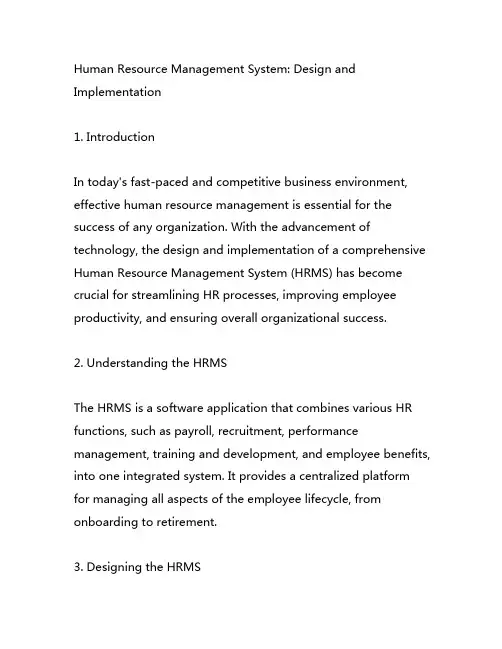
Human Resource Management System: Design and Implementation1. IntroductionIn today's fast-paced and competitive business environment, effective human resource management is essential for the success of any organization. With the advancement of technology, the design and implementation of a comprehensive Human Resource Management System (HRMS) has become crucial for streamlining HR processes, improving employee productivity, and ensuring overall organizational success.2. Understanding the HRMSThe HRMS is a software application that combines various HR functions, such as payroll, recruitment, performance management, training and development, and employee benefits, into one integrated system. It provides a centralized platform for managing all aspects of the employee lifecycle, from onboarding to retirement.3. Designing the HRMSWhen designing an HRMS, it is important to take into consideration the unique needs and requirements of the organization. This includes understanding the size of the workforce, the complexity of HR processes, and the overall business objectives. The design should focus on usability, scalability, and flexibility to accommodate future growth and changes in the organization.4. Implementing the HRMSThe implementation of an HRMS requires careful planning and execution. It involves data migration, system configuration, employee training, and change management. It is important to work closely with HR professionals and IT experts to ensure a smooth transition to the new system and minimize any disruptions to daily operations.5. Benefits of HRMSThe implementation of an HRMS brings numerous benefits to the organization. It automates repetitive tasks, reduces manual errors, and improves data accuracy. It also provides real-timeinsights and analytics, enabling better decision-making and strategic planning. Moreover, it enhances employee experience, engagement, and satisfaction by providing self-service tools and access to relevant information.6. Personal PerspectiveFrom my own experience, I believe that the design and implementation of an HRMS is a game-changer for any organization. It not only simplifies HR processes but also empowers HR professionals to focus on more strategic initiatives, such as talent management and succession planning. It also fosters a culture of transparency and accountability, leading to a more productive and motivated workforce.7. ConclusionIn conclusion, the design and implementation of a robust Human Resource Management System is a critical investment for any organization looking to optimize its HR functions and drive overall business success. By prioritizing user experience, scalability, and data-driven insights, an HRMS can revolutionize the way HR is managed and elevate the employee experience tonew heights.In summary, the comprehensive design and implementation of a Human Resource Management System are essential for organizations to streamline HR processes and ensure the overall success of the business. Through careful planning and execution, organizations can reap the benefits of improved efficiency, better decision-making, and enhanced employee satisfaction. With the right HRMS in place, organizations can set themselves up for long-term success in today's competitive business landscape.。
题目名称:Struts And Tiles Aid Component-basedDevelopment译文题目:Struts 和 Tiles 辅助基于组件的开发原文题目:Struts and Tiles aid component-based development 原文出处:Thinking in Java, 3rd ed. Revision 4.0Struts 和 Tiles 辅助基于组件的开发1994 年,当时主流的采用Web 应用程序的开发才刚开始。
由于Web 的不成熟,只有较少的工具能帮助开发人员构建Web 软件。
结果,在特定解决方案中的应用程序混合了HTML 代码与应用程序逻辑。
很显然,UI 设计的更改和业务逻辑的更新在大型应用程序中既困难又昂贵,因为紧耦合的表示和逻辑将这两种元素搅和在一起,进而导致错误和缓慢的进展。
而且,混合的代码要求部分开发人员具备UI 设计知识,或者要求开发人员与图形设计人员之间有紧密的工作关系,这常常会造成时间上的浪费。
JSP 技术和标记的引入稍微改善了这种更改问题,因为能够将逻辑和显示分离。
UI 设计人员能够对显示进行卓有成效的工作,同时开发人员能够专注于逻辑。
然而,这种方法仍存在一些缺陷。
尤其是某些操作(还有公共操作)的开发仍很困难。
验证表单就是典型的例子。
正如很多人所知,表单验证的过程类似于这样:显示表单;等待用户填写然后提交数据。
检查各个域值是否有效;如果有错误,则重新显示表单。
处理用户输入的数据,可能将其存储在一个数据库中。
在新页面上向用户显示处理的结果或下一步(可能是另一个表单)。
如果在这一过程中只使用JSP 页面,那么在需要再次更改代码时,您会发现,按照可管理性这条思路,将控制从一个页面“路由”至另一个页面很难。
您想把第4 步和第 3 步置于同一个页面吗?如果使用多个单独的JSP 页面,那么如何跟踪哪个页面链接至其它页面,以及在要更改一个页面的文件名或位置时该怎么做呢?而且,在第 2 步检测到某个域中的错误时,如何重新显示带有一条错误消息的原始表单,但还要保留用户已填入的值呢?Struts,一种开放源码“模型-视图-控制器”框架,通过帮助解决所有这些问题,从而使开发人员的工作更为轻松。
高校教师工作量管理系统的设计与实现本科毕业论文(设计) 论文题目:高校教师工作量管理系统的设计与实现学生姓名:雷红艳学号: 1005290122专业:软件工程班级:软件1001班指导教师:冯居易完成日期:2014年 5 月 18 日高校教师工作量管理系统的设计与实现摘要教师的工作量是衡量教师工作的重要信息,在信息高速发展的时代,利用信息化技术,可以准确、快速地统计教师工作量。
本系统采用技术,通过统计每学期教师教学工作量和科研工作量,并按照一定的计算规则,得出每学期每位教师的最终工作总量,以此为标准衡量教师的工作量情况。
系统包括管理员和教师两个权限,其中管理员的主要功能包括教师信息、学院信息、教学工作量信息、科研工作量信息的管理和工作量统计。
教师的主要功能包括实现个人资料修改和工作量查询。
本论文主要阐述了高校教师工作量系统的开发背景,所要完成的功能,系统设计与实现的过程。
系统运行稳定,加之权限的划分使系统的数据安全性得到保证。
系统的使用简便,用户界面设计简洁,功能较为完善。
关键词:工作量管理教学科研 B/S架构Design and Implementationof teacher workload management systemAbstractTeachers’workload is an important information to measure teachers’ work, in the era of rapid development of information. Accurate and reasonable teachers’workload began to rely on statistical computer management software.The system uses technology, by statistic the teachers’workload of per semester on teaching and Technology research, and calculated in accordance with certain rules. Take the final results of the total work as a standard to measure the workload of teachers’situation. This system includes two privileges that are administrator and teacher. The main function of the administrator include teacher information, college information administrators and teachers, teaching workload information, research and information management workload as well as workload statistics. The main function of teachers includes the realization of personal data to modify and query workload.This paper describes the design and implementation of university teachers’workload system for teachers’ teaching and research workload statistics. The system is stable, combined with data security division of authority so that it can be guaranteed. The system is easy to use system, simple to use interface design, and perfect to use the function.Key words:Workload management Teaching Technology Research B/S architecture目录一、绪论 0(一)项目开发的背景和意义 0(二)系统介绍 (1)(三)系统开发技术介绍 (2)1.B/S结构 (2)技术 (2)3.SQL Server 技术 (3)二、系统分析 (4)(一)可行性分析 (4)1.技术可行性 (4)2.经济可行性 (4)3.操作可行性 (5)(二)需求分析 (5)1.用户需求 (6)2.功能需求 (6)(三)数据流图 (8)(四)数据字典 (9)1.数据元素 (10)2.数据存储 (10)3.数据处理 (11)三、系统设计 (12)(一)系统功能设计 (12)1.管理员子系统 (13)2.教师子系统 (15)(二)系统流程图 (15)1.系统登录 (15)2.科研工作量计算 (16)3.查询工作量 (18)(三)数据库设计 (18)1.概念结构设计 (18)2.逻辑结构设计 (20)3.物理结构设计 (22)四、系统实现 (26)(一)用户登录界面 (26)(二)管理员子系统的实施 (26)1.管理员主界面 (26)2.管理员信息管理模块 (27)3.教师信息管理模块 (28)4.课程信息管理模块 (29)5.教学工作量信息管理模块 (30)6.科研工作量信息管理模块 (30)7.工作量统计模块 (31)(三)教师子系统的实施 (32)1.教师资料更改模块 (32)2.查询工作量统计模块 (32)3.修改密码模块 (33)五、系统测试 (34)(一)测试目的 (34)(二)测试方法及步骤 (34)1.登录界面测试 (35)2.功能测试 (36)(三)测试结果 (37)六、结论 (38)参考文献 (40)一、绪论(一)项目开发的背景和意义计算机的应用已经进入了人们活动的各个领域,管理系统的应运而生为各部门的日常管理工作提供了一个有力的帮手,这也体现了现代化管理的步伐正在一步步代替传统手工、人力的管理工作,同时也给高等教育的现代化管理工作提供了契机。
关于教师工作量管理系统的构建思路作者:赵婕来源:《价值工程》2014年第08期摘要:随着科学技术发展,高校教学管理已经不能仅仅局限于手工操作,尤其是教师工作量的管理,涉及教师人数较多,项目类别较广,这就要求各高校要有效利用信息资源,实现教师教学工作量系统管理,从而提高教学管理效率,完善学校信息化管理。
Abstract: With the development of science and technology, the teaching management in colleges and universities is not only limited to manual operation, especially the workload of teachers management, relates to a number of teachers and project categories, which requires all colleges and universities to use information resources effectivly, to promote the teaching workload of system management, so as to improve the efficiency of teaching management and improve the school information management.关键词:工作量;管理;系统Key words: workload;management;system中图分类号:G451.1 文献标识码:A 文章编号:1006-4311(2014)08-0215-020 引言随着高校人事制度的改革,学校对教师工作量的要求不只包含教师的教学工作量,为了激励教师在学术上的研究,将科研工作量也划归到教师工作量的要求当中。
《教务管理系统的设计与实现》篇一一、引言随着教育信息化的快速发展,教务管理系统已成为学校管理的重要工具。
教务管理系统能够有效地提高学校的管理效率,简化教学过程中的繁琐事务,提高教育质量。
本文将就教务管理系统的设计与实现进行详细探讨。
二、系统设计背景与目标教务管理系统的设计背景是基于当前教育领域对信息化、智能化管理的需求。
随着学校规模的不断扩大,教学管理任务日益繁重,传统的教务管理方式已无法满足现代教育的需求。
因此,设计并实现一套高效、便捷的教务管理系统显得尤为重要。
教务管理系统的设计目标主要包括:1. 提高教务管理效率,降低人工操作成本;2. 实现教学资源的优化配置,提高教学质量;3. 提供便捷的查询和统计功能,方便师生使用;4. 保障数据安全,提供可靠的备份和恢复机制。
三、系统设计原则1. 用户友好性:系统界面应简洁明了,操作便捷,方便师生使用。
2. 安全性:系统应具备完善的安全机制,保障数据的安全性和隐私性。
3. 可扩展性:系统应具备较好的可扩展性,以适应未来教育领域的发展变化。
4. 模块化设计:系统应采用模块化设计,便于后期维护和升级。
四、系统功能模块设计教务管理系统主要包括以下几个功能模块:1. 用户管理模块:负责用户信息的录入、修改和删除,以及用户权限的管理。
2. 课程管理模块:负责课程信息的录入、编辑和查询,包括课程名称、教师信息、上课时间、地点等。
3. 学生管理模块:负责学生信息的录入、学籍管理、成绩查询等。
4. 教学资源管理模块:负责教学资源的录入、分配和查询,包括教室、实验室、图书等资源。
5. 成绩管理模块:负责学生成绩的录入、查询和统计分析,支持多种查询方式和报表生成。
6. 系统设置模块:负责系统的基本设置、参数配置和日志管理等。
五、系统实现技术与方法教务管理系统采用B/S架构,使用Java语言进行开发,结合MySQL数据库进行数据存储。
在实现过程中,采用了以下技术与方法:1. 数据库设计:根据系统需求设计数据库结构,确保数据的安全性和可靠性。
基于Web的新疆大学教师工作量管理系统的设计与实现郑炅;王斌;刘光旭;付江龙【期刊名称】《现代计算机(专业版)》【年(卷),期】2012(000)022【摘要】Information management work of the teachers' workload occupy a very important position in the management of the schools and faculties. Building the standardized teacher workload manage- ment system is an urgent problem in each of the colleges and universities. The project estab- lishes the teachers' workload management system, relying on the network platform of Xinjiang University campus network. And it effectively solves the problems of the manual management mode, such as low efficiency, hard workload and high error rate, realizes teaching management specialization, standardization, process-oriented and obtaines praise.%高校教师工作量的管理工作在学校以及院系的信息管理工作中占据非常重要的地位。
构建标准化的教师工作量管理系统是每个高校亟需解决的问题。
该项目依托新疆大学校园网搭建的网络平台.建立了基于Web的教师工作量管理系统,切实解决了原来手工管理模式中效率低、工作量繁琐以及错误率高等问题,实现教学管理科学化、专业化、标准化、流程化,得到系统应用者的好评。
教学工作量管理系统的设计与实现【摘要】教学工作量管理系统的设计与实现是针对教师在工作中面临的教学任务安排、工作量评估等问题进行研究的。
本文首先从需求分析入手,明确了系统应具备的功能和特点,然后进行系统设计,包括系统结构和模块设计。
接着介绍系统的实现过程,包括开发环境、技术选型等方面。
随后进行系统测试,验证系统是否符合需求,并对系统进行优化,提高系统的性能和稳定性。
最终在结论部分总结了本文的研究成果,并展望了教学工作量管理系统未来的发展方向。
通过本文的研究与实现,为教师提供了一种便捷的工具,帮助他们更好地管理和分配教学工作量。
【关键词】教学工作量管理系统、设计、实现、需求分析、系统设计、系统实现、系统测试、系统优化、总结、展望、引言、研究背景、问题提出.1. 引言1.1 引言教学工作量管理系统的设计与实现是当前教育管理领域中备受关注的一个课题。
随着教育事业的不断发展,教师们的工作压力也日益增加,而如何科学合理地管理和分配教学工作量成为了一项迫切需要解决的问题。
教学工作量管理系统的出现,为教育管理者和教师们提供了一种便捷的工具,能够帮助他们更好地规划和安排教学任务,提高教学效率,减轻教师工作负担,保障教育教学质量。
在本文中,我们将围绕教学工作量管理系统进行详细的设计与实现,从系统的需求分析开始,通过对教学工作量管理的核心需求进行分析,明确系统的功能和特点。
然后,我们将介绍系统的设计过程,包括系统架构的设计、模块划分和关键算法的选择等。
接着,我们将详细描述系统的实现过程,包括技术选型、编码实现和数据库设计等方面。
我们将对系统进行测试和优化,确保系统的稳定性和性能最优化。
通过本文的研究和探讨,我们希望能够为教育管理者和教师们提供一个全面的教学工作量管理系统,帮助他们更好地管理和规划教学任务,提高教学效率,促进教育事业的健康发展。
1.2 研究背景教学工作量管理系统是现代高校管理中的重要组成部分,其设计与实现将有助于提高教学工作效率、优化资源配置、提升教育教学质量。
英文翻译数据库管理系统的介绍Raghu Ramakrishnan数据库(database,有时被拼作data base)又称为电子数据库,是专门组织起来的一组数据或信息,其目的是为了便于计算机快速查询及检索。
数据库的结构是专门设计的,在各种数据处理操作命令的支持下,可以简化数据的存储、检索、修改和删除。
数据库可以存储在磁盘、磁带、光盘或其他辅助存储设备上。
数据库由一个或一套文件组成,其中的信息可以分解为记录,每一条记录又包含一个或多个字段(或称为域)。
字段是数据存取的基本单位。
数据库用于描述实体,其中的一个字段通常表示与实体的某一属性相关的信息。
通过关键字以及各种分类(排序)命令,用户可以对多条记录的字段进行查询,重新整理,分组或选择,以实体对某一类数据的检索,也可以生成报表。
所有数据库(除最简单的)中都有复杂的数据关系及其链接。
处理与创建,访问以及维护数据库记录有关的复杂任务的系统软件包叫做数据库管理系统(DBMS)。
DBMS软件包中的程序在数据库与其用户间建立接口。
(这些用户可以是应用程序员,管理员及其他需要信息的人员和各种操作系统程序)DBMS可组织、处理和表示从数据库中选出的数据元。
该功能使决策者能搜索、探查和查询数据库的内容,从而对正规报告中没有的,不再出现的且无法预料的问题做出回答。
这些问题最初可能是模糊的并且(或者)是定义不恰当的,但是人们可以浏览数据库直到获得所需的信息。
简言之,DBMS将“管理”存储的数据项和从公共数据库中汇集所需的数据项用以回答非程序员的询问。
DBMS由3个主要部分组成:(1)存储子系统,用来存储和检索文件中的数(2)建模和操作子系统,提供组织数据以及添加、删除、维护、更新数据(3)用户和DBMS之间的接口。
在提高数据库管理系统的价值和有效性方面正在展现以下一些重要发展趋势:1.管理人员需要最新的信息以做出有效的决策。
2.客户需要越来越复杂的信息服务以及更多的有关其订单,发票和账号的当前信息。
3.用户发现他们可以使用传统的程序设计语言,在很短的一段时间内用数据库系统开发客户应用程序。
4.商业公司发现了信息的战略价值,他们利用数据库系统领先于竞争对手。
数据库模型数据库模型描述了在数据库中结构化和操纵数据的方法,模型的结构部分规定了数据如何被描述(例如树,表等):模型的操纵部分规定了数据添加、删除、显示、维护、打印、查找、选择、排序和更新等操作。
分层模型第一个数据库管理系统使用的是分层模型,也就是说,将数据记录排列成树形结构。
一些记录根目录,在其他所有记录中都有独立的父记录。
树形结构的设计反映了数据被使用的顺序,也就是首先访问处于树根位置的记录,接下来是根下面的记录等。
分层模型的开发是因为分层关系在商业应用中普遍存在。
众所周知,一个组织结构图表就描述了一种分层关系:高层管理人员在高层,中层管理人员在较低的层次,负责具体事务的雇员在底层。
值得注意的是,在一个严格的分层结构体系中,在每个管理层下可能有多个雇员或多个层次的雇员,但每个雇员只有一个管理者。
分层结构数据的典型特征是数据之间的一对多关系。
在分层方法中,当数据库建立时,每一关系即被明确地定义。
在分层数据库中的每一记录只能包含一个关键字段,任意两个字段之间只能有一种关系。
由于数据并不总是遵循这种严格的分层关系,所以这样可能会出现一些问题。
关系模型在1970年,数据库研究取得了重大突破。
E.F.Codd提出了一种截然不同的数据库管理方法,使用表作为数据结构,称之为关系模型.关系数据库是使用最广的数据结构,数据被组织成关系表,每个表由称作记录的行和称作字段的列组成。
每个记录包含了专用项目的字段值。
例如,在一个包含雇员信息的表中,一个记录包含了像一个人姓名和地址这样的字段的值。
结构化查询语言(SQL)是一种在关系型数据库中用于处理数据的查询语言。
它是非过程化语言或者说是描述性的,用户只须指定一种类似于英语的描述,用来确定操作、记录或描述记录组合。
查询优化器将这种描述翻译为过程执行数据库操作。
网状模型网状模型在数据之间通过链接表结构创建关系,子记录可以链接到多个父记录。
这种将记录和链接捆绑到一起的方法叫做指针,它是指向一个记录存储位置的存储地址。
使用网状方法,一个子记录可以链接到一个关键记录,同时,它本身也可以作为一个关键记录链接到其他一系列子记录。
在早期,网状模型比其他模型更有性能优势,但是在今天,这种优势的特点只有在自动柜员机网络,航空预定系统等大容量和高速处理过程中才是最重要的。
分层和网状数据库都是专用程序,如果开发一个新的应用程序,那么在不同的应用程序中保持数据库的一致性是非常困难的。
例如开发一个退休金程序,需要访问雇员数据,这一数据同时也被工资单程序访问。
虽然数据是相同的,但是也必须建立新的数据库。
对象模型最新的数据库管理方法是使用对象模型,记录由被称作对象的实体来描述,可以在对象中存储数据,同时提供方法或程序执行特定的任务。
对象模型使用的查询语言与开发数据库程序所使用的面向对象的程序设计语言是相同的,因为没有像SQL这样简单统一的查询语言,所以会产生一些问题。
对象模型相对较新,仅有少数几个面向对象的数据库实例。
它引起了人们的关注,因为选择面向对象程序设计语言的开发人员希望有一个基于在对象模型基础上的数据库。
分布式数据库类似的,分布式数据库指的是数据库的各个部分分别存储在物理上相互分开的计算机上。
分布式数据库的一个目的是访问数据信息时不必考虑其他位置。
注意,一旦用户和数据分开,通信和网络则开始扮演重要角色。
分布式数据库需要部分常驻于大型主机上的软件,这些软件在大型机和个人计算机之间建立桥梁,并解决数据格式不兼容的问题。
在理想情况下,大型主机上的数据库看起来像是一个大的信息仓库,而大部分处理则在个人计算机上完成。
分布式数据库系统的一个缺点是它们常以主机中心模型为基础,在这种模型中,大型主机看起来好像是雇主,而终端和个人计算机看起来好像是奴隶。
但是这种方法也有许多优点:由于数据库的集中控制,前面提到的数据完整性和安全性的问题就迎刃而解。
当今的个人计算机,部门级计算机和分布式处理都需要计算机之间以及应用程序之间在相等或对等的基础上相互通信,在数据库中客户机/服务器模型为分布式数据库提供了框架结构。
利用相互连接的在计算机上运行的数据库应用程序的一种方法是将程序分解为相互独立的部分。
客户端是一个最终用户或通过网络申请资源的计算机程序,服务器是一个运行着的计算机软件,存储着那些通过网络传输的申请。
当申请的资源是数据库中的数据时,客户机/服务器模型则为分布式数据库提供了框架结构。
文件服务器指的是一个通过网络提供文件访问的软件,专门的文件服务器是一台被指定为文件服务器的计算机,这是非常有用的。
例如,如果文件比较大而且需要快速访问,在这种情况下,一台微型计算机或大型主机将被用作文件服务器。
分布式文件服务器将文件分散到不同的计算机上,而不是将它们集中存放到专门的文件服务器上。
后一种文件服务器拥有在其他计算机上存储和检索文件的能力,并可以在每一台计算机上消除重复文件。
然而,一个重要的缺点是每个读写请求需要在网络上传播,在刷新文件时可能出现问题。
假设一个用户申请文件中的一个数据并修改它,同时另外一个用户也申请这个数据并修改它,解决这种问题的方法叫做数据锁定,即第一个申请使其他申请处于等待状态,直到完成第一个申请,其他用户可以读取这个数据,但不能修改。
数据库服务器是一个通过网络为数据库申请提供服务的软件。
例如,假设某个用户在他的个人计算机上输入了一个数据查询命令,如果应用程序按照客户机/服务器模型设计,那么个人计算机上的查询语言通过网络传送到数据库服务器上,当发现数据时发出通知。
在工程界也有许多分布式数据库的例子,如SUN公司的网络文件系统(NFS)被应用到计算机辅助工程应用程序中,将数据分散到由SUN工作站组成的网络上的不同硬盘之间。
英文原文Database Management Systems( 3th Edition ),Wiley ,2004, 5-12 AnIntroduction to Database Management SystemRaghu RamakrishnanA database (sometimes spelled data base) is also called an electronic database, referring to any collection of data or information, and that is specially organized for rapid search and retrieval by a computer. Databases are structured to facilitate the storage, retrieval, modification, and deletion of data in conjunction with various data-processing operations .Databases can be stored on magnetic disk or tape, optical disk, or some other secondary storage device.A database consists of a file or a set of files. The information in these files may be broken down into records, each of which consists of one or more fields. Fields are the basic units of data storage, and each field typically contains information pertaining to one aspect or attribute of the entity described by the database. Using keywords and various sorting commands, users can rapidly search, rearrange, group, and select the fields in many records to retrieve or create reports on particular aggregate of data.Complex data relationships and linkages may be found in all but the simplest databases.The system software package that handles the difficult tasks associated with creating,accessing, and maintaining database records is called a database management system(DBMS).The programs in a DBMS package establish an interface between the database itself and the users of the database. (These users may be applications programmers, managers and others with information needs, and various OS programs)A DBMS can organize, process, and present selected data elements form the database. This capability enables decision makers to search, probe, and query database contents in order to extract answers to nonrecurring and unplanned questions that aren’t available in regular reports. These questions might initially be vague and/or poorly defined,but people can “browse” through the database until they have the needed information. In short, the DBMS will “manage” the stored data items and assemble the needed items from the common database in response to the queries of those who aren’t programmers.A database management system (DBMS) is composed of three major parts:(1)a storage subsystem that stores and retrieves data in files;(2) a modeling and manipulation subsystem that provides the means with which to organize the data and to add, delete, maintain, and update the data;(3)and an interface between the DBMS and its users. Several major trends are emerging that enhance the value and usefulness of database management systems:1.Managers: who require more up-to-data information to make effective decision.2.Customers: who demand increasingly sophisticated information services and more current information about the status of their orders, invoices, and accounts.ers: who find that they can develop custom applications with database systems in a fraction of the time it takes to use traditional programming languages.anizations: that discover information has a strategic value; they utilize their database systems to gain an edge over their competitors.The Database ModelA data model describes a way to structure and manipulate the data in a database. The structural part of the model specifies how data should be represented(such as tree, tables, and so on).The manipulative part of the model specifies the operation with which to add, delete, display, maintain, print, search, select, sort and update the data.Hierarchical ModelThe first database management systems used a hierarchical model-that is-they arranged records into a tree structure. Some records are root records and all others have unique parent records. The structure of the tree is designed to reflect the order in which the data will be used that is,the record at the root of a tree will be accessed first, then records one level below the root,and so on.The hierarchical model was developed because hierarchical relationships are commonly found in business applications. As you have known, an organization char often describes a hierarchical relationship: top management is at the highest level, middle management at lower levels, and operational employees at the lowest levels. Note that within a strict hierarchy, each level of management may have many employees or levels of employees beneath it, but each employee has only one manager. Hierarchical data are characterized by this one-to-many relationship among data.In the hierarchical approach, each relationship must be explicitly defined when the database is created. Each record in a hierarchical database can contain only one key field and only one relationship is allowed between any two fields. This can create a problem because data do not always conform to such a strict hierarchy.Relational ModelA major breakthrough in database research occurred in 1970 when E. F. Codd proposed a fundamentally different approach to database management called relational model,which uses a table as its data structure.The relational database is the most widely used database structure. Data is organized into related tables. Each table is made up of rows called and columns called fields. Each record contains fields of data about some specific item. For example, in a table containing information on employees, a record would contain fields of data such as a person’s last name, first name,and street address.Structured query language(SQL)is a query language for manipulating data in a relational database.It is nonprocedural or declarative, in which the user need only specify an English-like description that specifies the operation and the described record or combination of records. A query optimizer translates the description into a procedure to perform the database manipulation.Network ModelThe network model creates relationships among data through a linked-list structure in which subordinate records can be linked to more than one parent record. This approach combinesrecords with links, which are called pointers. The pointers are addresses that indicate the location of a record. With the network approach, a subordinate record can be linked to a key record and at the same time itself be a key record linked to other sets of subordinate records. The network mode historically hashad a performance advantage over other database models. Today, such performance characteristics are only important in high-volume,high-speed transaction processing such as automatic teller machine networks or airline reservation system.Both hierarchical and network databases are application specific. If a new application is developed,maintaining the consistency of databases in different applications can be very difficult. For example, suppose a new pension application is developed.The data are the same, but a new database must be created.Object ModelThe newest approach to database management uses an object model, in which records are represented by entities called objects that can both store data and provide methods or procedures to perform specific tasks.The query language used for the object model is the same object-oriented programming language used to develop the database application.This can create problems because there is no simple, uniform query language such as SQL. The object model is relatively new, and only a few examples of object-oriented database exist. It has attracted attention because developers who choose an object-oriented programming language want a database based on an object-oriented model.Distributed DatabaseSimilarly, a distributed database is one in which different parts of the database reside on physically separated computers. One goal of distributed databases is the access of information without regard to where the data might be stored. Keeping in mind that once the users and their data being separated, the communication and networking concepts come into play.Distributed databases require software that resides partially in the larger computer. This software bridges the gap between personal and large computers and resolves the problems of incompatible data formats. Ideally, it would make the mainframe databases appear to be large libraries of information, with most of the processing accomplished on the personal computer.A drawback to some distributed systems is that they are often based on what is called a mainframe-entire model, in which the larger host computer is seen as the master and the terminal or personal computer is seen as a slave. There are some advantages to this approach. With databases under centralized control, many of the problems of data integrity that we mentioned earlier are solved. But today’s personal computers, departmental computers, and distributed processing require computers and their applications to communicate with each other on a more equal or peer-to-peer basis. In a database, the client/server model provides the framework for distributing databases.One way to take advantage of many connected computers running database applications is to distribute the application into cooperating parts that are independent of one anther. A client is an end user or computer program that requests resources across a network. A server is a computer running software that fulfills those requests across a network. When the resources are data in a database,the client/server model provides the framework for distributing database.A file server is software that provides access to files across a network. A dedicated file server is a single computer dedicated to being a file server. This is useful, for example,if the files are large and require fast access.In such cases, a minicomputer or mainframe would be used as a file server. A distributed file server spreads the files around on individual computers instead of placing them on one dedicated computer.Advantages of the latter server include the ability to store and retrieve files on other computers and the elimination of duplicate files on each computer. A major disadvantage, however, is that individual read/write requests are being moved across the network and problems can arise when updating files. Suppose a user requests a record from a file and changes it while another user requests the same record and changes it too. The solution to this problemcalled record locking, which means that the first request makes others requests wait until the first request is satisfied. Other users may be able to read the record, but they will not be able to change it.A database server is software that services requests to a database across a network. For example, suppose a user types in a query for data on his or her personal computer. If the application is designed with the client/server model in mind,the query language part on the personal computer simple sends the query across the network to the database server and requests to be notified when the data are found.Examples of distributed database systems can be found in the engineering world. Sun’s Network Filing System(NFS),for example, is used in computer-aided engineering applications to distribute data among the hard disks in a network of Sun workstation.。